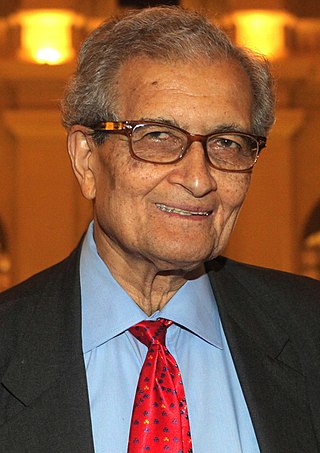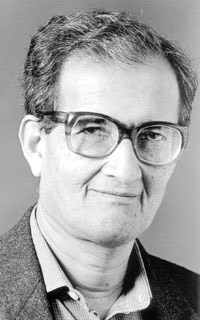Rational choice theory refers to a set of guidelines that help understand economic and social behaviour. The theory originated in the eighteenth century and can be traced back to political economist and philosopher, Adam Smith. The theory postulates that an individual will perform a cost–benefit analysis to determine whether an option is right for them. It also suggests that an individual's self-driven rational actions will help better the overall economy. Rational choice theory looks at three concepts: rational actors, self interest and the invisible hand.

Amartya Kumar Sen is an Indian economist and philosopher, who since 1972 has taught and worked in the United Kingdom and the United States. Sen has made contributions to welfare economics, social choice theory, economic and social justice, economic theories of famines, decision theory, development economics, public health, and measures of well-being of countries.
Bounded rationality is the idea that rationality is limited when individuals make decisions, and under these limitations, rational individuals will select a decision that is satisfactory rather than optimal.
Satisficing is a decision-making strategy or cognitive heuristic that entails searching through the available alternatives until an acceptability threshold is met. The term satisficing, a portmanteau of satisfy and suffice, was introduced by Herbert A. Simon in 1956, although the concept was first posited in his 1947 book Administrative Behavior. Simon used satisficing to explain the behavior of decision makers under circumstances in which an optimal solution cannot be determined. He maintained that many natural problems are characterized by computational intractability or a lack of information, both of which preclude the use of mathematical optimization procedures. He observed in his Nobel Prize in Economics speech that "decision makers can satisfice either by finding optimum solutions for a simplified world, or by finding satisfactory solutions for a more realistic world. Neither approach, in general, dominates the other, and both have continued to co-exist in the world of management science".
Arrow's impossibility theorem, the general possibility theorem or Arrow's paradox is an impossibility theorem in social choice theory that states that when voters have three or more distinct alternatives (options), no ranked voting electoral system can convert the ranked preferences of individuals into a community-wide ranking while also meeting the specified set of criteria: unrestricted domain, non-dictatorship, Pareto efficiency, and independence of irrelevant alternatives. The theorem is often cited in discussions of voting theory as it is further interpreted by the Gibbard–Satterthwaite theorem. The theorem is named after economist and Nobel laureate Kenneth Arrow, who demonstrated the theorem in his doctoral thesis and popularized it in his 1951 book Social Choice and Individual Values. The original paper was titled "A Difficulty in the Concept of Social Welfare".

A Theory of Justice is a 1971 work of political philosophy and ethics by the philosopher John Rawls (1921–2002) in which the author attempts to provide a moral theory alternative to utilitarianism and that addresses the problem of distributive justice . The theory uses an updated form of Kantian philosophy and a variant form of conventional social contract theory. Rawls's theory of justice is fully a political theory of justice as opposed to other forms of justice discussed in other disciplines and contexts.
In philosophy, economics, and political science, the common good is either what is shared and beneficial for all or most members of a given community, or alternatively, what is achieved by citizenship, collective action, and active participation in the realm of politics and public service. The concept of the common good differs significantly among philosophical doctrines. Early conceptions of the common good were set out by Ancient Greek philosophers, including Aristotle and Plato. One understanding of the common good rooted in Aristotle's philosophy remains in common usage today, referring to what one contemporary scholar calls the "good proper to, and attainable only by, the community, yet individually shared by its members."

Decision theory is a branch of applied probability theory and analytic philosophy concerned with the theory of making decisions based on assigning probabilities to various factors and assigning numerical consequences to the outcome.
New institutionalism is an approach to the study of institutions that focuses on the constraining and enabling effects of formal and informal rules on the behavior of individuals and groups. New institutionalism traditionally encompasses three major strands: sociological institutionalism, rational choice institutionalism, and historical institutionalism. New institutionalism originated in work by sociologist John Meyer published in 1977.

The liberal paradox, also Sen paradox or Sen's paradox, is a logical paradox proposed by Amartya Sen which shows that no means of aggregating individual preferences into a single, social choice, can simultaneously fulfill the following, seemingly mild conditions:
- The unrestrictedness condition, or U: every possible ranking of each individual's preferences and all outcomes of every possible voting rule will be considered equally,
- The Pareto condition, or P: if everybody individually likes some choice better at the same time, the society in its voting rule as a whole likes it better as well, and
- Liberalism, or L : all individuals in a society must have at least one possibility of choosing differently, so that the social choice under a given voting rule changes as well. That is, as an individual liberal, anyone can exert their freedom of choice at least in some decision with tangible results.
Philosophy and economics studies topics such as public economics, behavioural economics, rationality, justice, history of economic thought, rational choice, the appraisal of economic outcomes, institutions and processes, the status of highly idealized economic models, the ontology of economic phenomena and the possibilities of acquiring knowledge of them.
Social choice theory or social choice is a theoretical framework for analysis of combining individual opinions, preferences, interests, or welfares to reach a collective decision or social welfare in some sense. Whereas choice theory is concerned with individuals making choices based on their preferences, social choice theory is concerned with how to translate the preferences of individuals into the preferences of a group. A non-theoretical example of a collective decision is enacting a law or set of laws under a constitution. Another example is voting, where individual preferences over candidates are collected to elect a person that best represents the group's preferences.
Revealed preference theory, pioneered by economist Paul Anthony Samuelson in 1938, is a method of analyzing choices made by individuals, mostly used for comparing the influence of policies on consumer behavior. Revealed preference models assume that the preferences of consumers can be revealed by their purchasing habits.
Allan Fletcher Gibbard is the Richard B. Brandt Distinguished University Professor of Philosophy Emeritus at the University of Michigan, Ann Arbor. Gibbard has made major contributions to contemporary ethical theory, in particular metaethics, where he has developed a contemporary version of non-cognitivism. He has also published articles in the philosophy of language, metaphysics, and social choice theory: in social choice, he first proved the result known today as Gibbard-Satterthwaite theorem, which had been previously conjectured by Michael Dummett and Robin Farquharson.

The mathematical notion of quasitransitivity is a weakened version of transitivity that is used in social choice theory and microeconomics. Informally, a relation is quasitransitive if it is symmetric for some values and transitive elsewhere. The concept was introduced by Sen (1969) to study the consequences of Arrow's theorem.
In psychology, economics and philosophy, preference is a technical term usually used in relation to choosing between alternatives. For example, someone prefers A over B if they would rather choose A than B. Preferences are central to decision theory because of this relation to behavior. Some methods such as Ordinal Priority Approach use preference relation for decision-making. As connative states, they are closely related to desires. The difference between the two is that desires are directed at one object while preferences concern a comparison between two alternatives, of which one is preferred to the other.

Kevin W. S. Roberts was the Sir John Hicks Professor of Economics at the University of Oxford until his retirement in 2020.
Prasanta Kumar Pattanaik, is an Indian-American emeritus professor at the Department of Economics at the University of California. He is a Fellow of the Econometric Society.
Fractional social choice is a branch of social choice theory in which the collective decision is not a single alternative, but rather a weighted sum of two or more alternatives. For example, if society has to choose between three candidates: A B or C, then in standard social choice, exactly one of these candidates is chosen, while in fractional social choice, it is possible to choose "2/3 of A and 1/3 of B". A common interpretation of the weighted sum is as a lottery, in which candidate A is chosen with probability 2/3 and candidate B is chosen with probability 1/3. Due to this interpretation, fractional social choice is also called random social choice, probabilistic social choice, or stochastic social choice. But it can also be interpreted as a recipe for sharing, for example:
Rational choice is a prominent framework in international relations scholarship. Rational choice is not a substantive theory of international politics, but rather a methodological approach that focuses on certain types of social explanation for phenomena. In that sense, it is similar to constructivism, and differs from liberalism and realism, which are substantive theories of world politics. Rationalist analyses have been used to substantiate realist theories, as well as liberal theories of international relations.





